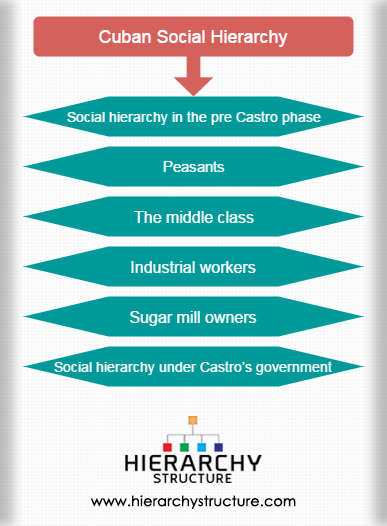The case of Cuban social hierarchy is a bit complicated than other countries. Here there is the question of ethnicity, race, and money is mixed up to form various classes. Moreover, there is a claim that Cuba after the coming of the communist government got rid of social hierarchy. How far this claim is true should be seen too, in the context of social hierarchy. What is more likely that one type of hierarchical set up was replaced by another of a different kind.

The Cuban social hierarchy should be divided into two phases, the pre Castro phase and the post Castro phase.
- Social hierarchy in the pre Castro phase- Before the advent of the 1959 revolution that brought Fidel Castro to power in Cuba, the Cuban society was sharply divided into a few classes such as peasants, mill owners, middle class etc.
- Peasants- They are at the lowest rank of the society. They survived on the small plots of land which they cultivated. More often than not, that land was far too often for them to make ends meet. Their position in the society was really bad.
- The middle class- Cuba unlike many other countries, prior to 1959 had a strong middle class. Middle class consisted of doctors, social workers, lawyers, and other such professionals. They enjoyed considerable authority.
- Industrial workers- The industrial workers of the Cuban society enjoyed more power than their counterparts in other Latin American countries. They were an organized group and have more active unions. This also means that they had better standards of living than many others in the same rank as they are, in some other countries.
- Sugar mill owners- As against the poor peasant class, there was a class of Sugar mill owners, who enjoyed considerable power and prestige in the country.
Apart from these classes, there were some other groups such as, rich colonos, sharecroppers, and tenant farmers engaged in the cultivation of sugarcane in the country of Cuba.
- Social hierarchy under Castro’s government- After Castro successfully seized power it was claimed that the rift between the rich and poor was done away with. Earlier most of the poor people were of color and the situation was bad for black women. It was argued that after 1959, the situation changed for better. Indeed, there was a change in the society with the change of the government, yet, society did not become egalitarian as a whole. Under this government, people engaged in the army, the communist party and in the government job enjoyed a higher position than the others. Among them, they almost form a group of privileged people. Moreover, after 1970s the government somewhat loosened the economic restrictions. This made the rift between the richer section of the society and the poor more widespread. People of color also remain oppressed.
However, while talking about the Cuban hierarchy one might do well to keep in mind that the Cuban government is striving towards a society where people are more or less equals.
Know about Cuban Political Hierarchy.
